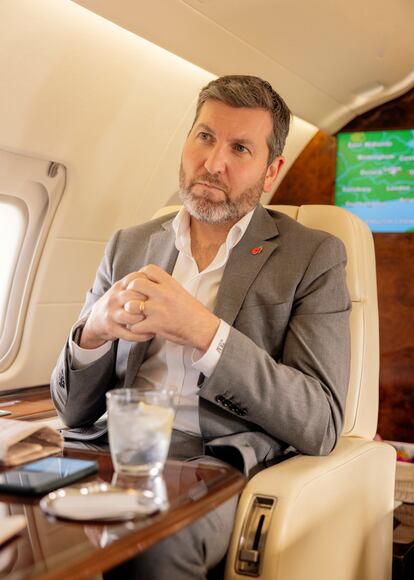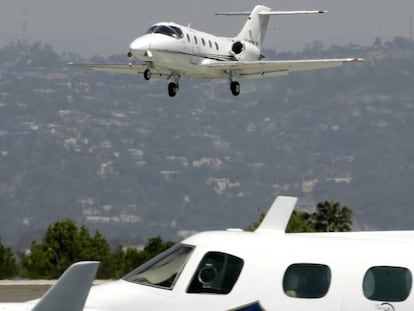The unstoppable rise of private aviation
More than 23,000 private jets transport 0.0008% of the world’s population faster than commercial flights. Every year about 600 new aircraft are added to an already booming business. The industry’s contribution to climate change and the risk of investment bubbles are the shadowy side of a sector that turns over more than $38 billion a year

If luxury is mostly to do with exclusivity and enjoying what is forbidden to others, the ultimate privilege would be a time machine. “We sell something that is not for sale to ordinary mortals: time. It’s a commodity that is difficult to trade. We are a time machine. I can get the manager of an investment fund, from their villa on the coast to their home six hours faster than it would take to take a commercial flight. And if that option cost you $15,000 more than it would cost to take your entire family on a scheduled flight, you’d choose it without blinking.”
The speaker is John Matthews, the founder and CEO of AirX. The private aviation company is based in Malta and has operational centers in London, and its fleet of 16 aircraft operates in Europe. Matthews is something of a disruptor in his sector. Not known to mince his words, he has no qualms about describing the true nature — or at least the truth as he understands it — of a business that turns over more than $38 billion a year worldwide, and is projected to reach $60 billion in 2030, according to the consulting firm Fortune Business Insights.
There will be time to return to Matthews later in this feature. He will lay out his stark vision of a business whose clients represent 0.0008% of the world’s population — mostly men over 50 years old who work in banking, finance, and real estate.

Right now, the Sikorsky S-76 helicopter is about to take off from Battersea heliport on the south bank of the Thames. It is a cloudy morning in London, and visibility problems have put the 20-minute flight to Farnborough airport in jeopardy. The alternative would be at least two hours on the road, with hellish traffic. The customer is the priority and, as soon as there is the slightest improvement in the weather, the aircraft heads to its destination. The waiting time was spent comfortably in a luxurious waiting room next to the helipad with tea, coffee, Danish pastries, and liquors all freely available.
The helicopter has leather seats, a soundproof cabin, large windows and space for eight people. It is part of a global fleet that includes 18 more helicopters and 270 jets, including the mid-size Praetor 600 and the much sought-after long-haul Gulfstream G650. They all belong to Flexjet, a company that has been operating since 1995. Based in Cleveland (Ohio), it was launched to conquer the European market shortly before the pandemic, in 2019.

In Farnborough, where it has its tactical control center, Flexjet has also set up the Red Label Academy. It is a culinary laboratory, a kind of finishing school for the cabin crew to learn good manners and the rules of etiquette. Leading the project is Francesco Vanerio, vice president for customer experience. Throughout his professional career he held positions of responsibility in top-flight hotels and restaurants around the world. The culmination of that career trajectory came when he attained the position of Bar Manager at Villa D’Este, the palace on the shores of Lake Como, in northern Italy. The resort symbolizes all the luxury and refinement to which the rich and powerful can aspire. “That’s where I met Flexjet president Kenn Ricci. The rest is history,” explains Vanerio.
It is a story that is easily envisioned. Ricci aspired to elevate the customer experience in an extremely competitive industry, where 5.4 million flights were made in 2022 alone. And he managed to coax the Italian bar manager into joining his company.

In groups of eight or ten, the company’s cabin crew spend a night at the Dorchester Hotel in London. For years, it was the most exclusive in the city and a favorite destination for aristocrats, billionaires, established writers, and artists. It has a restaurant with three Michelin stars and very little tolerance for shorts or sneakers. For several hours, Flexjet workers can order whatever they want and wander around the hotel at their leisure. The goal is to put themselves in the shoes of their future clients, and understand the type of luxury to which they are accustomed.
The next morning, they share their experiences: “the decor is so elegant”; “everything seems tailored to your preferences”; “they read your mood, and they know when to insist and when not to bother you.” The crew will learn to make exquisite dishes in a small space and will receive tips on how to surprise and delight their passengers.
“The decor in each of our jets is different and unique. And our attention to detail reaches the point of finding out the type of wine that will satisfy a customer the most,” explains Megan Wolf, the company’s Chief Experience Officer. “Although we did manage to transfer a group of young senior executives who demanded hamburgers and fries from a well-known fast food chain. ‘The best experience of their lives,’ they told us later,” says Wolf ironically.
Flexjet operates under the shared ownership economic model (fractional ownership, as it is known in the United States). The owner — the company never calls them customers — purchases a fraction of the aircraft (typically 1/16) and earns a minimum of 50 flight hours per year, with no option to terminate the contract for the first three years. The advance payment, with no refunds, is just over $2 million.

There are other commercial options, ranging from simply hiring flight hours in advance to charter flights for a specific occasion. In the end, all of these are much better than owning an aircraft individually, with the maintenance, crew, and refueling costs that would entail. The price of a new Cessna CJU, probably the cheapest and lightest jet on the market today, does not go below $4.4 million.
On board a G650, luxuriating in its spacious leather seats and surrounded by noble wood trimming, life takes on a different perspective. The cabin attendant pours a glass of Ruinart champagne, and begins to serve the salmon and cucumber sandwiches of a traditional English afternoon tea.

“Isn’t using this type of aircraft an attack against efforts to combat climate change?” the reporter asks.
Global commercial aviation is responsible for at least 3.5% of human-related climate change. Not only with the emission of carbon dioxide and nitrogen, but with other polluting agents such as smoke and soot trails. Private aviation barely accounts for 4% of the sector’s total emissions. But if individuals are to take personal responsibility for the level of pollution, it is evident that, proportionally, a flight taken by a handful of people is much more harmful to the environment than 300 or more travelers flying on a commercial jet.
“We acquire up to 300% in offsets [emission reduction certificates, verified by international standards, which serve to reduce the total volume of greenhouse gases in global terms] for the carbon and other gases we emit, and we even give our customers the option of traveling with sustainable aviation fuel,” Viv Diprose, Flexjet’s communications director argues.
Such exclusive companies, that offer a service that is only available to a few, strive to promote a more accessible image. It is true that during the pandemic, the use of private jet increased by up to 40%, and it is still an option that remains immensely attractive for the extremely wealthy. But it is doubtful that this type of flight is now more available to other types of client, despite what its publicity says.
And any effort to provide bespoke service and individual attention will be appreciated by users, but that will not be the main factor in them spending their money.
“Rubbish. We are not a sector that focuses on service, although it is obvious that we are not going to feed people from carts like on a commercial airplane.” We return to Matthews, the rebellious businessman. “Nor does it depend on the details. If the blind on one of the windows on my jet breaks tomorrow, I’m not going to ground a device that produces $25,000 a day just to fix it. It will continue flying until the day the maintenance check comes round. We all have a damaged seat that doesn’t recline properly or a carpet stained with food residue (...) The key is to have a comfortable, spacious cabin. But on many of my aircraft I don’t have Wi-Fi. I continue to offer entertainment with CDs or DVDs. It doesn’t matter. I can transport a sports star or a famous singer, who is tired after a game or concert, to any point in Europe five hours quicker than any commercial airline. That’s what’s worth money,” he argues.

The number of private jets worldwide has increased from 9,895 in 2000 to 23,133 in June 2022. An increase of 133%. About 600 new aircraft each year, according to data from the High Flyers 2023 report from the U.K.’s Institute for Policy Studies. The general consensus among analysts suggests that the sector is robust, and its future is promising. Matthew, however, has decided to play Jiminy Cricket. He remarks that there are dozens of companies that have taken on crazy debt to acquire aircraft valued at $40 or $50 million. They have all prospered around a fairy tale, says the owner of AirX, which in many cases is hiding a pyramid scam. The money advanced by new clients pays for the service promised to previous ones, in a business characterized by fierce competition and limited profit margins.
“When you board a commercial plane, you are protected by the airline, your travel agency, or the consumer protection watchdog itself. But the private jet industry is unregulated. I can go to my broker’s website and buy a flight from Azerbaijan, Luton, or Mongolia. No one cares if a billionaire loses his money on a failed charter,” says Matthews. “But behind them there are savers who have bought bonds or shares, debtors who have supplied fuel or catering, and hundreds of workers who make a living from this,” he says. But the sector will continue because, as the businessman points out with some irony, this boom has generated a lot of addicts. Billionaires will not travel any other way once they have flown by private jet. A new world of technological geniuses has emerged who have accumulated immense fortunes. They are the industry’s main clients.

The helicopter is returning to Battersea heliport. At night the lights of London enhance the image of the city as a metropolis that is used to being the business hub for the transactions of the rich and powerful from all over the planet. As the helicopter is about to land, the pilot begins to circle over the skyscrapers like a bird of prey. The runway is occupied by another craft that has had problems. We will have to detour to another facility in the west of the city, and wait there for the green light. We are half an hour late. For any commercial airline traveler that would be an insignificant amount of time, but it is an exception to be avoided in the exclusive world of private jets.
Sign up for our weekly newsletter to get more English-language news coverage from EL PAÍS USA Edition
Tu suscripción se está usando en otro dispositivo
¿Quieres añadir otro usuario a tu suscripción?
Si continúas leyendo en este dispositivo, no se podrá leer en el otro.
FlechaTu suscripción se está usando en otro dispositivo y solo puedes acceder a EL PAÍS desde un dispositivo a la vez.
Si quieres compartir tu cuenta, cambia tu suscripción a la modalidad Premium, así podrás añadir otro usuario. Cada uno accederá con su propia cuenta de email, lo que os permitirá personalizar vuestra experiencia en EL PAÍS.
¿Tienes una suscripción de empresa? Accede aquí para contratar más cuentas.
En el caso de no saber quién está usando tu cuenta, te recomendamos cambiar tu contraseña aquí.
Si decides continuar compartiendo tu cuenta, este mensaje se mostrará en tu dispositivo y en el de la otra persona que está usando tu cuenta de forma indefinida, afectando a tu experiencia de lectura. Puedes consultar aquí los términos y condiciones de la suscripción digital.
More information
Últimas noticias
David Bowie, the galactic thinker who encouraged us to break new ground
John Berger and the loss of rural culture
From police officer to bloodthirsty kidnapper: Terror in Mexico during the years of ‘The Ear Chopper’
Alain Aspect, Nobel laureate in physics: ‘Einstein was so smart that he would have had to recognize quantum entanglement’
Most viewed
- David King, chemist: ‘There are scientists studying how to cool the planet; nobody should stop these experiments from happening’
- Reinhard Genzel, Nobel laureate in physics: ‘One-minute videos will never give you the truth’
- Oona Chaplin: ‘I told James Cameron that I was living in a treehouse and starting a permaculture project with a friend’
- Mexico completes its trade shift with the entry into force of tariffs on China and countries without trade agreements
- Sinaloa Cartel war is taking its toll on Los Chapitos











































